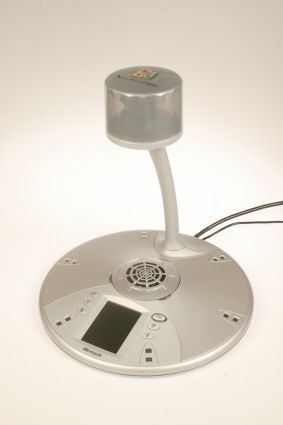Microsoft introduces 360-degree conferencing camera as part of VoIP strategy
San Francisco (CA) - At what had been billed as a rollout event for the company's Office Communications and "softphone" software yesterday, Microsoft Business Division President Jeff Raikes unveiled an intriguing new plank of what the company now calls its Unified Communications Platform: Utilizing Office Communications software and Microsoft's VoIP services, hardware manufacturers including Hewlett-Packard, LG-Nortel, and Samsung will be making available a new class of communications devices, not only for messaging but for audio and videoconferencing. Among these devices is a 360-degree camera designed for video conferences called RoundTable, that has apparently emerged from a back-burner project called RingCam from Microsoft's laboratories.

The latest prototype of Microsoft's RoundTable 360-degree videoconferencing camera, demonstrated yesterday.
With Microsoft's software driving an online videoconference session, and the RoundTable camera placed atop a conference table, remote participants will see the face or faces of the active speakers as they assume the floor. Participants who may grow weary of the angle changes during heated arguments may prefer the optional panorama view. Documents and PowerPoint slides can also be featured into the picture, synchronized with cues provided by the speakers.
"The virtual meeting experience can be, should be, and maybe in some ways be even better than actually being in the room," Raikes told attendees yesterday. "One of the things that we've learned from our research is that it's possible to view the meeting in about half the time just by using good compression of the normal pauses in human speech - which, of course, leads to the great paradox: If you can review the meeting in half the time after the meeting, who wants to go to the meeting in the first place?"
To demonstrate the potential usefulness of the RoundTable camera in future videoconferences, Raikes participated in a mock session with various product managers and sitcom stars, engaged in a scripted argument over what to order for lunch.
The objective behind the RoundTable device is apparently to sweeten Microsoft's value proposition for its voice-over-IP service, which will need some bolstering in the face of the continuing expansion of Skype, now owned by eBay. Major network equipment providers Linksys (part of Cisco) and Netgear have already announced Skype phones, in so doing, making it clear that anyone who wants to seriously compete in the VoIP field will need a substantive hardware offering.
So here again, that vital term "leverage" will be used in conjunction with Microsoft, to describe how it intends to make use of a business it has already conquered to venture into a business it has barely entered into. "Microsoft is uniquely positioned, given our software focus," said Raikes yesterday. "The advances in software for communications, we already have deep investments in communications, we've already delivered on the basics of unified communications with Microsoft Exchange, our communications server, Outlook, Office Communicator and Live Meeting. We are truly using the software, the power of software to drive the next wave of innovation in the way people communicate at work."
Stay on the Cutting Edge
Join the experts who read Tom's Hardware for the inside track on enthusiast PC tech news — and have for over 25 years. We'll send breaking news and in-depth reviews of CPUs, GPUs, AI, maker hardware and more straight to your inbox.
That said, it will still take hardware for Microsoft to be able to make its VoIP play profitable; and with one or two noteworthy except
